
Airdrie is a town in North Lanarkshire, Scotland. It lies on a plateau roughly 400 ft above sea level, and is approximately 12 miles (19 km) east of Glasgow city centre. As of 2012, the town had a population of around 37,130. Historically part of Lanarkshire, Airdrie forms part of a conurbation with its neighbour Coatbridge, in what is commonly known as the Monklands, formerly a district..
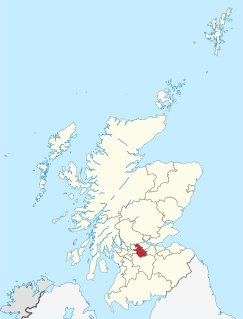
North Lanarkshire is one of 32 council areas of Scotland. It borders the northeast of the City of Glasgow and contains many of Glasgow's suburbs and commuter towns and villages. It also borders East Dunbartonshire, Falkirk, Stirling, South Lanarkshire and West Lothian. The council covers parts of the traditional counties of Dunbartonshire, Lanarkshire and Stirlingshire.

Lanarkshire, also called the County of Lanark, is a historic county, lieutenancy area and registration county in the central Lowlands of Scotland.

Coatbridge is a town in North Lanarkshire, Scotland, about 8.5 miles (13.5 km) east of Glasgow city centre, set in the central Lowlands. While the earliest known settlement of the area dates back to the Stone Age era, the founding of the town can be traced to the 12th century, when a Royal Charter was granted to the monks of Newbattle Abbey by King Malcolm IV. Along with neighbouring town Airdrie, Coatbridge forms the area known as the Monklands, often considered to be part of the Greater Glasgow urban area – although officially they have not been included in population figures since 2016 due to small gaps between the Monklands and Glasgow built-up areas.
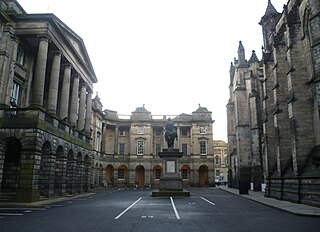
Parliament House in the Old Town in Edinburgh, Scotland, is a complex of several buildings housing the Supreme Courts of Scotland. The original building was home to the Parliament of Scotland from 1639 to 1707. It is located in the Old Town, just off the High Street section of the Royal Mile, beside St Giles' Cathedral. Buildings in the complex are Grade A listed buildings.

Calderbank is a village outside the town of Airdrie, North Lanarkshire, Scotland. It lies west of the M73, on the west bank of the North Calder Water. The village lies 13 miles (21 km) east of Glasgow city centre and around 34 miles (55 km) west of Edinburgh. Other nearby towns include: Airdrie, Coatbridge, Bellshill and Motherwell. It has a population of about 1,560 (mid-2020 est.)

The Monkland Canal was a 12+1⁄4-mile-long (19.7 km) canal designed to bring coal from the mining areas of Monklands to Glasgow in Scotland. In the course of a long and difficult construction process, it was opened progressively as short sections were completed, from 1771. It reached Gartcraig in 1782, and in 1794 it reached its full originally planned extent, from pits at Calderbank to a basin at Townhead in Glasgow; at first this was in two sections with a 96-foot (29 m) vertical interval between them at Blackhill; coal was unloaded and carted to the lower section and loaded onto a fresh barge. Locks were later constructed linking the two sections, and the canal was also connected to the Forth and Clyde Canal, giving additional business potential.

Easterhouse is a suburb of Glasgow, Scotland, located on the periphery of the city approximately 6 miles (10 km) east of its centre, partially built on land gained from the county of Lanarkshire as part of a boundary expansion of Glasgow prior to the Second World War. The area is on high ground north of the River Clyde and south of the River Kelvin and Campsie Fells.
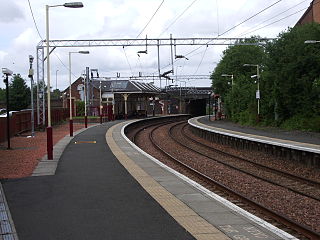
Coatbridge Sunnyside railway station serves the town of Coatbridge in North Lanarkshire, Scotland. The railway station is managed by ScotRail and is located on the North Clyde Line, 9 miles (14 km) east of Glasgow Queen Street.
Airdrie Public Library is a public library in Airdrie, North Lanarkshire, Scotland. The library has been housed in a number of buildings since its founding.
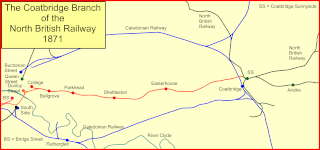
The Coatbridge Branch of the North British Railway was a railway built to connect the important coal and iron industrial districts of Coatbridge and Airdrie directly to Glasgow for the North British Railway.
The history of Coatbridge, Scotland, is one of dramatic change. The town transformed from an obscure group of 18th century Lanarkshire hamlets strung out on the road between Glasgow and Airdrie to a world leading centre of iron production in the 19th century. Development took off at an incredible rate in the 19th century and led to massive changes to the landscape and an explosion in the population.
Though Coatbridge is a most interesting seat of industry, it is anything but beautiful. Dense clouds of smoke roll over it incessantly, and impart to all the buildings a peculiarly dingy aspect. A coat of black dust overlies everything, and in a few hours the visitor finds his complexion considerably deteriorated by the flakes of soot which fill the air, and settle on his face. To experience Coatbridge it must be visited at night when it presents a most extraordinary spectacle.... From the steeple of the parish church the flames of no fewer than fifty blast furnaces may be seen.... The flames have a positively fascinating effect. Now they shoot far upward, and breaking off short, expire among the smoke; again spreading outward, they curl over the lips of the furnace, and dart through the doorways, as if determined to annihilate the bounds within which they are confined; then they sink low into the crater, and come forth with renewed strength in the shape of great tongues of fire, which sway backward and forward, as if seeking with a fierce eagerness something to devour. The Scotsman, 1869

Peter Womersley was a British architect, best known for his work in the modernist style. He lived in the Scottish Borders, where a number of his buildings are located, although he worked on projects throughout the UK. Influenced principally by the work of Frank Lloyd Wright, and by the American Case Study Houses, Womersley's buildings employ such typical modernist elements as in-situ concrete and strong geometric forms, although he introduced a wider palette of materials than was typically used by Le Corbusier and his followers.
James Davidson, JP FRIBA was a Scottish architect. He also served as a Provost of Coatbridge and a President of Airdrie Savings Bank.
The Seven Lochs Wetland Park is an urban park that is due to be created in Scotland. It will comprise nearly 20 km² of land and water between Glasgow and Coatbridge.

Broomhouse is a residential area in Glasgow, Scotland. It is about 6 miles (10 km) east of the city centre. Historically a small mining village and later the site of the Glasgow Zoo, in the early 21st century it grew substantially as an affluent commuter suburb.
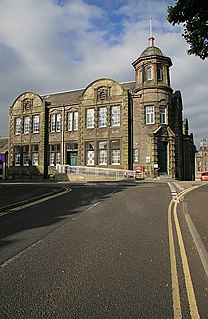
Hawick Library is housed in the building built in 1904 in Hawick and it was one of the many libraries funded by Andrew Carnegie. The library is a Category B listed building. The library, designed by J N Scott and Alexander Lorne Campbell, is a 2-storey, rectangular-plan Free Style library with a prominent corner entrance tower and round-arched gables. The library is described as "a good example of early-20th-century civic architecture."

Coatbridge Municipal Buildings, formerly Coatbridge Town Hall, is a municipal building in Dunbeth Road, Coatbridge, North Lanarkshire, Scotland. The building, which was the headquarters of Coatbridge Burgh Council, is a Category B listed building.

Airdie Town House is a municipal building in Bank Street, Airdrie, North Lanarkshire, Scotland. The town house, which was the headquarters of Airdrie Burgh Council, is a Category B listed building.
















